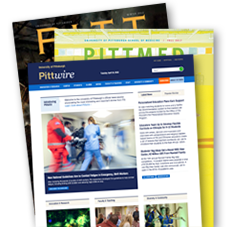UNIVERSITY OF PITTSBURGH HARNESSES POWER OF IBM RS/6000 IN CREATION OF MOLECULAR SIMULATION LABORATORY IBM Servers Aid Students, Faculty in Nanotechnology Research
PITTSBURGH, Sept. 2 -- The University of Pittsburgh will announce today that a newly installed $900,000 cluster of IBM RS/6000 computers will serve as the cornerstone of a new molecular simulation laboratory. Researchers at the laboratory will use the RS/6000 cluster to tackle a wide range of scientific problems. Computer simulations on nanotubes—carbon tubes that are 10,000 times thinner than a human hair—are of particular interest to researchers at IBM. Real-world applications for nanotubes range from pushing the physical limits on the miniaturization of transistors on computer chips to creating safer materials to store energy sources that will power cars of the future.
The Laboratory of Molecular Simulations and Material Sciences (LMMS) will bridge for the first time the research efforts of students and faculty in science and engineering in their theoretical studies of the properties of complex molecules and materials.
"Computational methods are playing an increasingly important role in modeling and designing complex molecules and materials in both academia and industry," said Rod Adkins, general manager, IBM RS/6000. "IBM and the University of Pittsburgh are enabling academic researchers to assemble high performance computer clusters that will be capable of running complex simulations in a parallel environment. This advanced scientific tool will also offer students both superb scientific and practical computational training."
"With the RS/6000s in place at LMMS, the University of Pittsburgh is creating a highly powerful computing environment to foster collaborative research among individuals in biology, chemistry, physics and engineering," said Ken Jordan, professor of chemistry at the University of Pittsburgh. "The experience our students will gain here is something they will carry over into their professional lives."
With research projects already underway, students and faculty now have access to powerful yet affordable parallel processing computer platforms. Sixteen of the computers are connected via a gigabit ethernet switch from Foundry Networks, enabling high bandwidth communications for demanding parallel applications.
Nanotube Research
As the electronic circuits on computer chips become smaller and smaller, conventional transistors run into physical limitations caused by extreme miniaturization. To build those devices, scientists must be able to manipulate these tubes to the highest degree of accuracy. Nanotubes hold the promise of creating single-electron transistors that will allow the miniaturization to continue beyond the limits of current silicon-based device technology. Carbon nanotubes consist of rolled up sheets of carbon hexagons. Nanotubes have the potential for use as minuscule wires or in ultrasmall electronic devices.
To build these devices using nanotubes, researchers are conducting simulations to understand how they interact with surfaces and electrical contacts. There is also interest in using carbon nanotubes for hydrogen storage for fuel applications and using nanotubes to safely transport chemical reactants to specific reactant sites. This will eventually serve as the basis for nanoscale chemical reactors, which are being constructed by faculty in the University's chemistry department.
Other work at LMMS includes Scanning Tunneling Microscopy (STM). STM was developed by scientists at IBM in Zurich, and is used to characterize and modify surfaces at the atomic level. This will be important to the semiconductor industry for its potential to advance the technology of information storage. Researchers here are also studying the behavior of excess electrons in water. This will help explain how oxidation and corrosion take place in the presence of water, leading to the creation of more waterproof materials.
The LMMS was made possible from combining a $350,000 Shared University Research (SUR) Grant from IBM with a grant from the Major Research Instrumentation program at the National Science Foundation and additional support from the University of Pittsburgh. The University's Chemistry and Chemical Engineering Departments spearheaded efforts to establish the LMMS.
IBM, RS/6000, SP and AIX are registered trademarks or trademarks of the International Business Machines Corporation in the United States, other countries, or both. UNIX is a registered trademark in the United States and other countries, licensed exclusively through X/Open Company, Limited. Other company, product and service names, which may be denoted by a double asterisk (**) may be trademarks or service marks of others.
-30-
9/2/99/shg
Media Resources
Schools of the Health Sciences Media Relations
For more information about Pitt's schools of dental medicine, health and rehabilitation sciences, medicine, nursing, pharmacy, and public health, click here >
To locate stories from health science schools prior to 2013, visit the UPMC news archives »
Urgent Question?
University of Pittsburgh news reps are available to answer urgent media inquiries. Outside of regular business hours (Mon-Fri, 8:30 a.m.-5 p.m.), please email us at media@pitt.edu.
News reps for University of Pittsburgh Health Sciences schools can be reached outside of regular business hours through the paging operator at 1+412-647-2345.


